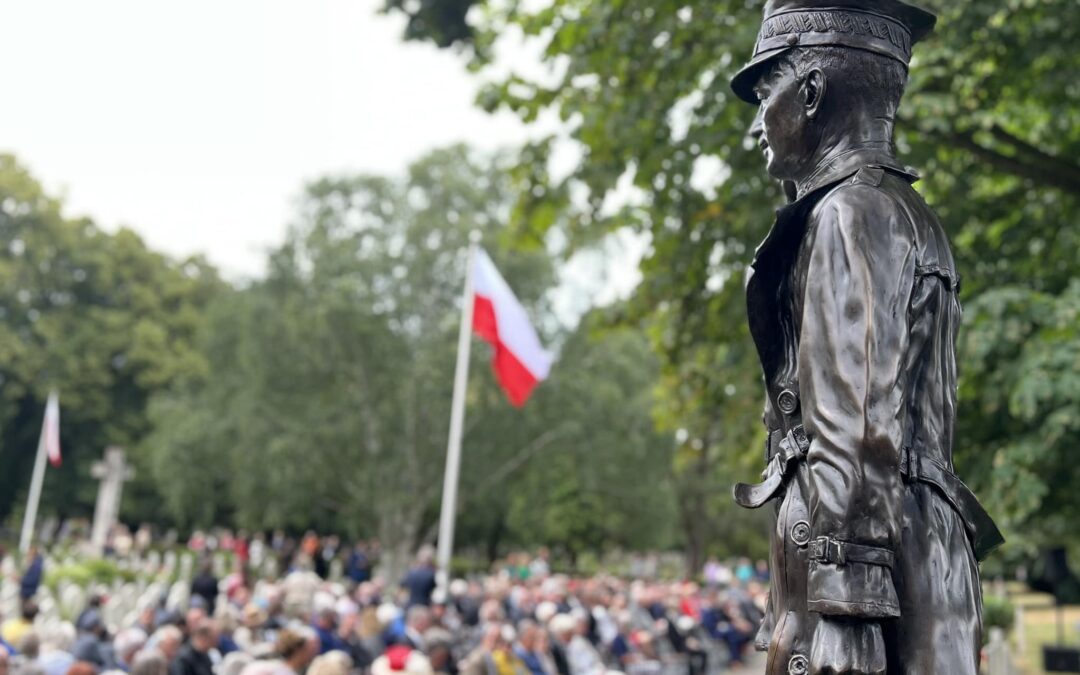A statue of Władysław Sikorski, the general who led Poland’s government-in-exile during World War Two, has been unveiled in the UK on the 80th anniversary of his 1943 death in a plane crash that remains unexplained.
The life-size bronze figure was commissioned by the local authorities in the town of Newark in Nottinghamshire – where a Polish war cemetery is located – and the Polish Cultural Institute in London. Sikorski is depicted saluting in the direction of a cross on the Polish war memorial that he himself unveiled in 1941.
Two years earlier, Sikorski had been among the Polish leaders to escape Poland as German forces occupied the country, setting up a government-in-exile first in Paris, then in Angers and, after the fall of France, finally in London. He became its prime minister and the commander-in-chief of the Polish armed forces.
The cemetery in Newark was created for the hundreds of Polish airmen who died while fighting to defend the British skies during the war. They played a central role during the Battle of Britain, in which Poles were the largest group of non-British pilots.
“To mark the 80th anniversary of [Sikorski’s] death, it is fitting that we have a statue erected in his memory in Newark watching over his fallen comrades,” said Paul Peacock, leader of Newark council. “It is a great honour for our town to have played such an important part in the history of Poland.”
“The 80th anniversary of Sikorski’s death offers a chance to raise awareness among non-Poles of the significant Polish-British relationship that existed during WWII,” added Marta de Zuniga, director of the Polish Culture Institute.”It is an opportunity to rediscover Britain’s forgotten ally and celebrate his achievements.”
Sikorski died on 4 July 1943 when his plane crashed shortly after taking off from Gibraltar, where he had stopped off on his return to the UK after inspecting Polish troops stationed in the Middle East.
A British investigation found the crash to have been an accident, but its findings were not accepted by the Polish government. Over the decades, various theories have been put forward that the incident was deliberately caused by a Soviet, British or even Polish conspiracy, though no conclusive evidence has been found.
His loss was seen as a huge blow to Poland’s cause during the war. After Sikorski’s death, Winston Churchill mourned the loss of a man who was “a statesman, a soldier, a comrade, an ally and, above all, a Pole”.
#VEDay70 Poland and Britain fought side by side throughout #WW2 'for your freedom and ours'. #Churchill #Sikorski pic.twitter.com/VkTUynKPlB
— Polish Embassy UK 🇵🇱 (@PolishEmbassyUK) May 8, 2015
Sikorski’s remains were laid to rest in the Newark cemetery. In 1993, they were repatriated to Poland, where they were interred in the royal crypts at Wawel Castle in Kraków. Last year, the remains of three other Polish leaders-in-exile were also repatriated from Newark to Warsaw.
The new statue of Sikorski is the work of sculptor Andrew Lilley, who also created a monument in Newark to Irena Sendler, the Polish social worker who saved hundreds, and possibly thousands, of Jewish children from the Warsaw ghetto.
“I hope the people of Newark will take General Sikorski to their hearts as they have Irena,” Lilley told local newspaper the Newark Advertiser.
The remains of Poland’s first three presidents-in-exile, who served from 1939 to 1979, are to be moved from the UK to a pantheon honouring great Poles in Warsaw.
They "preserved the idea of an independent, sovereign, free state", says @ipngovpl https://t.co/Wq4Ny8AsW7
— Notes from Poland 🇵🇱 (@notesfrompoland) September 28, 2022
Main image credit: Newark and Sherwood District Council/Facebook

Daniel Tilles is editor-in-chief of Notes from Poland. He has written on Polish affairs for a wide range of publications, including Foreign Policy, POLITICO Europe, EUobserver and Dziennik Gazeta Prawna.



















